Complete Solutions to All Questions of chapter THERMAL PROPERTIES OF MATTER of Class 11 book with complete answers and questions
| Class 11 | PHYSICS |
| Chapter | THERMAL PROPERTIES OF MATTER |
| DISHA | All Questions |
| Number Of Questions | 44 |
| Academic Year | 2023-24 |
The total radiant energy per unit area, normal to the direction of incidence, received at a distance `R` from the centre of a star of radius `r` whose outer surface radiates as a black body at a temperature `T K` is given by
(where `sigma` is Stefan's constant)
View Solution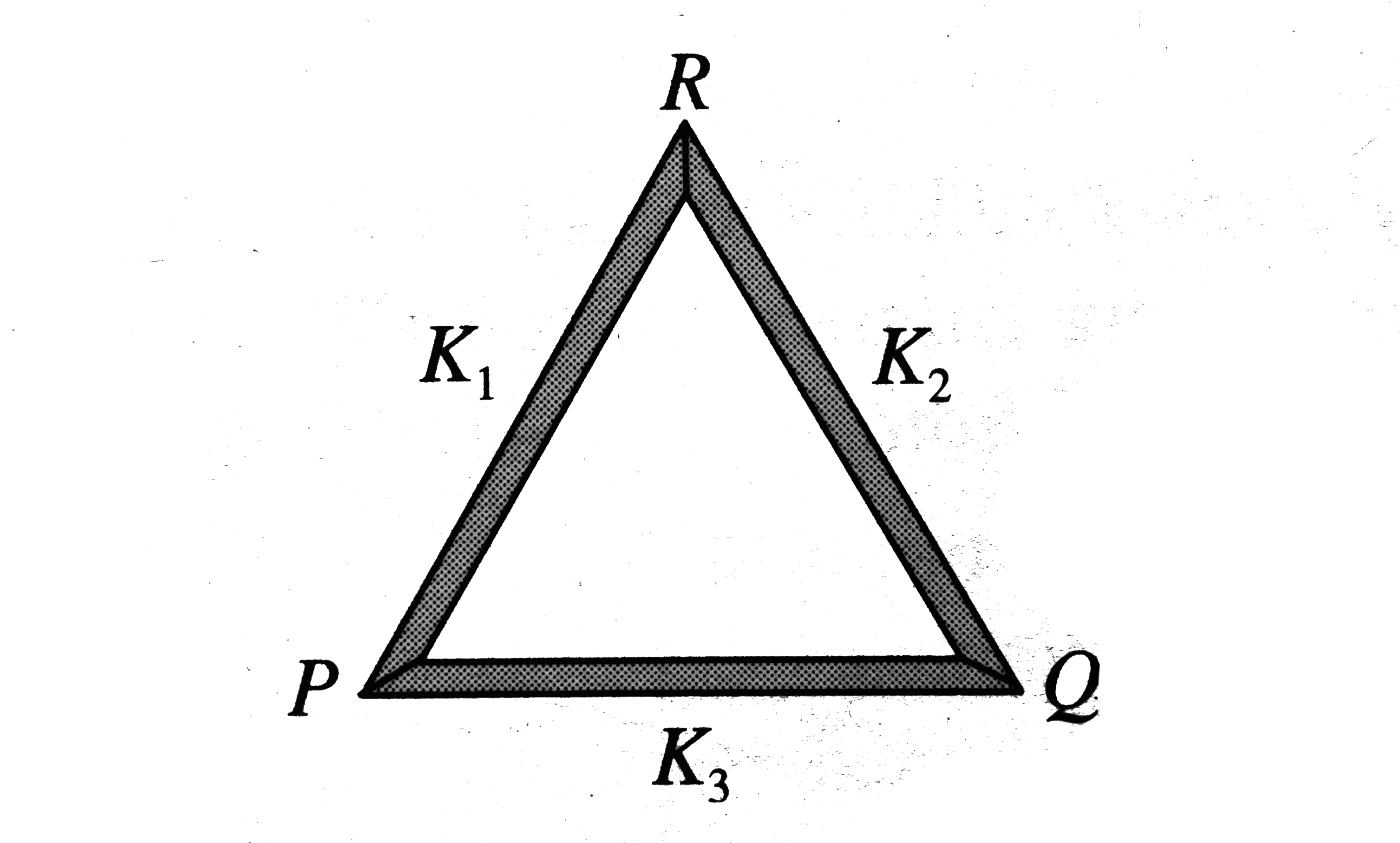
Three rods of same dimensions are arranged as shown in Fig. They have thermal conductivities `K_1`,`K_2` and `K_3`. The points P and Q are maintained at different temeperature for the heat to flow at the same rate along PRQ and PQ. Whi of the following options correct?
View SolutionThe sprinkling of wate slightly reduces the temperature of a closed room because
View SolutionThe specific heat capacity of a metal at low temperature (T) is given as
`C_(p)(kJK^(-1) kg^(-1)) =32((T)/(400))^(3)`
A 100 gram vessel of this metal is to be cooled from `20^(@)K` to `4^(@)K` by a special refrigerator operating at room temperaturte `(27^(@)C)` . The amount of work required to cool the vessel is
View SolutionThe emissive power of a black body at `T=300K` is `100Watt//m^(2)` consider a body B of area `A=10m^(2)` coefficient of reflectivity `r=0.3` and coefficient of transmission `t=0.5` its temperature is 300 K. then which of the followin is correct:
View SolutionA solid cube and a solid sphere of the same material have equal surface area. Both are at the same temperature `120^(@)C`, then
View SolutionThe density of water at `20^(@)"C is 998 kg/m"^(3)` and at` 40^(@)"C 992 kg/m"^(3)`. The coefficient of volume expansion of water is
View SolutionA metallic rod l cm long, A square cm in cross-section is heated through `t^(@)"C"`. If Young’s modulus of elasticity of the metal is E and the mean coefficient of linear expansion is `alpha` per degree celsius, then the compressional force required to prevent the rod from expanding along its length is
View SolutionIf liquefied oxygen at 1 atmospheric pressure is heated from 50K to 300k by supplying heat at constant rate. The graph of temperature vs time will be
View SolutionIf a bar is made of copper whose coefficient of linear expansion is one and a half times that of iron, the ratio of force developed in the copper bar to the iron bar of identical lengths and cross-sections, when heated through the same temperature range (Young’s modulus of copper may be taken to be equal to that of iron) is
View SolutionA piece of ice falls from a height `h` so that it melts completely. Only one-quarter of the heat produced is absobed by the ice and all energy of ice gets converted into heat during its fall. The value of `h` is
[Latent heat of ice is `3.4 xx 10^(5) J//kg` and `g = 10 N//kg`]
View SolutionA body of mass 5 kg falls from a height of 20 metres on the ground and it rebounds to a height of 0.2 m. If the loss in potential energy is used up by the body, then what will be the temperature rise? `("specific heat of material = 0.09 cal gm"^(–1@)"C"^(–1))`
View SolutionTwo straight metallic strips each of thickness t and length l are rivetted together. Their coefficients of linear expansions are` alpha_(1) "and" alpha_(2) `. If they are heated through temperature `DeltaT`, the bimetallic strip will bend to form an arc of radius
View SolutionThe figure shows a system of two concentric spheres of radii `r_1 and r_2` are kept at temperature `T_1 and T_2`, respectively. The radial rate of flow of heat in a substance between the two concentric spheres is proportional to
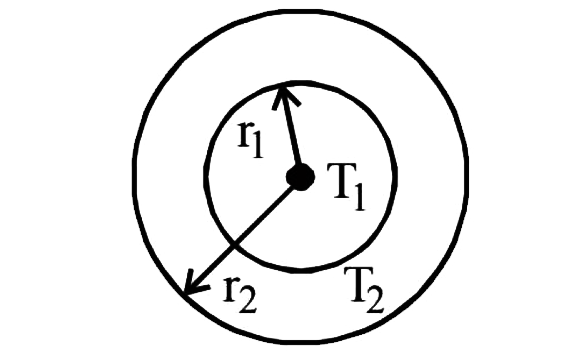
View SolutionA block of steel heated to `100^(@)C` is left in a room to cool Which of the curves shown in the represents the correct behaviour
 .
.
View SolutionWhich of the following will expand the most for same rise in temperature?
View SolutionThe plots of intensity versus wavelength for three black bodies at temperatures `T_(1),T_(2)` and `T_(3)` respectively are shown in Their temperatures are shown in How their temperatures are related ?
 .
.
View SolutionWhen the temperature of a rod increases from t to `r+Delta t`, its moment of inertia increases from I to `I+Delta I`. If `alpha` is the value of `Delta I//I` is
View SolutionTwo rods, one of aluminium and other made of steel, having initial lengths `l_(1) and l_(2)` are connected together to form a single rod of length `(l_(1)+l_(2))`. The coefficient of linear expansions for aluminium and steel are `alpha_(a)` and `alpha_(s)` respectively. If length of each rod increases by same amount when their tempertures are raised by `t^(@)C`, then find the ratio `l_(1) (l_(1)+l_(2))`.
View SolutionA polished metal plate with a rough black spot on it is heated to about `1400K` and quickly taken into dark room Then .
View SolutionOn observing light from three different stars `P`, `Q` and `R`, it was found that intensity of violet colour is maximum in the spectrum of `P`, the intensity of green colour is maximum in the spectrum of `R` and the intensity of red colour is maximum in the spectrum of `Q`. if `T_(P)`, `T_(Q)` and `T_(R)` are respective absolute temperature of `P`, `Q` and `R`. then it can be concluded from the above observation that
View SolutionA partition wall has two layers of different materials A and B in contact with each other. They have the same thickness but the thermal conductivity of layer A is twice that of layer B. At steady state the temperature difference across the layer B is 50 K, then the corresponding difference across the layer A is
View SolutionWhich of the following statements is/are false about mode of heat transfer?
View SolutionIn a vertical `U`-tube containing a luquid, the two arms are maintained at different temperatures, `t_(1)` and `t_(2)` . The liquid coplumns in the two arms have heights `l_(1)` and `l_(2)` respectively. The coefficient of volume expansion of the liquid is equal to
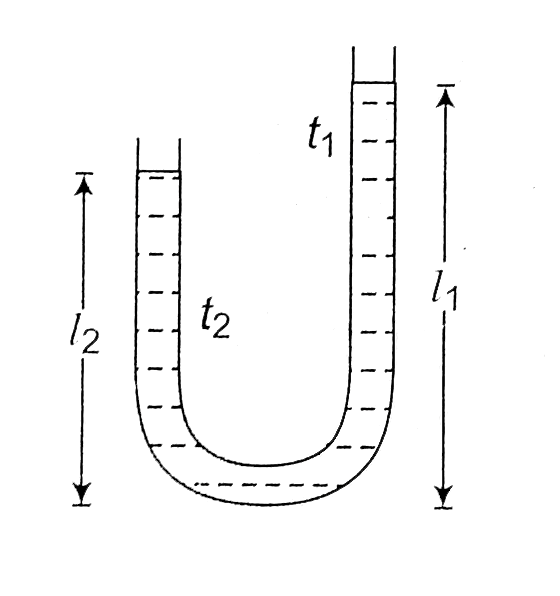
View SolutionThe top of an insulated cylindrical container is covered by a disc having emissivity 0.6 and conductivity 0.167 `"WK"^(– 1)m^(–1)` and thickness 1 cm. The temperature is maintained by circulating oil as shown in figure. Find the radiation loss to the surrounding in `"Jm"^(–2)s^(–1 )`if temperature of the upper surface of the disc is `27^(@)"C"` and temperature of the surrounding is `27^(@)"C"`.
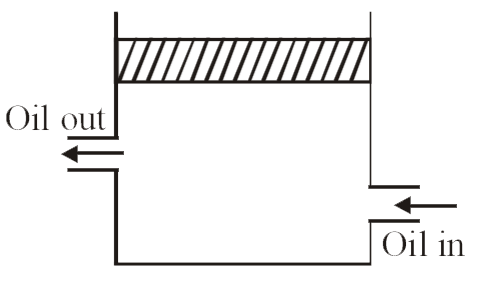
View SolutionWien's law is concerned with
View SolutionIf a piece of metal is heated to temperature `theta` and the allowed to cool in a room which is at temperature `theta_0`, the graph between the temperature T of the metal and time t will be closet to
View SolutionTwo rods of same length and transfer a given amount of heat 12 second, when they are joined as shown in figure (i). But when they are joined as shwon in figure (ii), then they will transfer same heat in same conditions in

View SolutionConsider a compound slab consisting of two different material having equal thickness and thermal conductivities `K` and `2K` respectively. The equivalent thermal conductivity of the slab is
View SolutionThe coefficient of thermal conductivity of copper, mercury and glass are respectively `K_(c), K_(m)` and `K_(g)` that `K_(c) gt K_(m) gt K_(g)`. If the same quantity of heat is to flow per second per unit of each and corresponding temperature gradients are `X_(c), X_(m)` and `X_(g)`, then
View SolutionThe radiation energy density per unit wavelength at a temperature T has a maximum at a wavelength` lambda_(0)`. At temperature 2T, it will have a maximum wavelength
View SolutionAssuming the Sun to be a spherical body of radius R at a temperature of TK, evaluate the total radiant powered incident of Earth at a distance r from the sun
where `r_0` is the radius of the Earth and `sigma` is Stefan's constant.
View SolutionA metal ball immersed in alcohol weights `W_1` at `0^@C` and `W_2` at `50^@C`. The coefficient of expansion of cubical the metal is less than that of the alcohol. Assuming that the density of the metal is large compared to that of alcohol, it can be shown that
View SolutionOne end of thermally insulated rod is kept at a temperature `T_(1)` and the other at `T_(2)`. The rod is composed of two section of length `l_(1)` and `l_(2)` thermal conductivities `k_(1)` and `k_(2)` respectively. The temerature at the interface of two section is
View SolutionTwo spheres of different materials one with double the radius and one-fourth wall thickness of the other are filled with ice. If the time taken for complete melting of ice in the larger sphere is `25` minutes and for smaller one is `16` minutes, the ratio of thermal conductivities of the materials of larger sphere to that of smaller sphere is:
View SolutionA black body has maximum wavelength `lambda_(m)` at temperature `2000 K`. Its corresponding wavelength at temperature 3000 will be
View SolutionA solid material is supplied heat at a constant rate. The temperature of material is changing with heat input as shown in the figure. What does the slope of DE represent ?
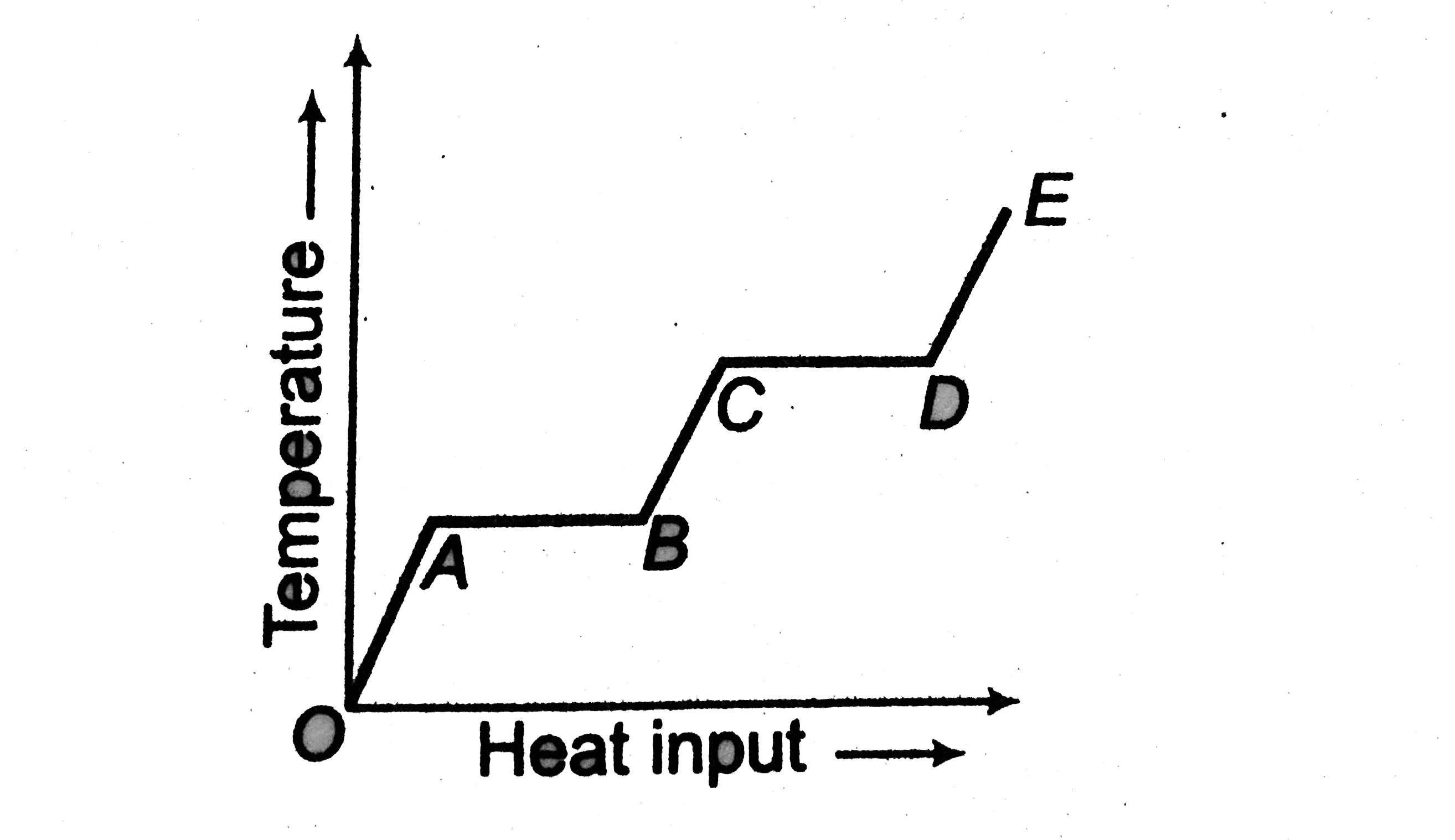
View Solution10 gm of ice cubes at `0^(@)"C"` are released in a tumbler (water equivalent 55 g) at `40^(@)"C"`. Assuming that negligible heat is taken from the surroundings, the temperature of water in the tumbler becomes nearly` "(L = 80 cal/g)"`
View SolutionIn a surrounding medium of temperature `10^(@)"C"`, a body takes 7 min for a fall of temperature from `60^(@)"C to 40"^(@)"C"`. In what time the temperature of the body will fall from `40^(@)"C to 28"^(@)"C"`
View SolutionTwo rods of same length and area of cross-section `A_(1)" and" A_(2)` have their ends at the same temperature. If `K_(1) "and" K_(2)` are their thermal conductivities, `c_(1) "and" c_(2)` are their specific heats and `d_(1) "and "d_(2)` are their densities, then the rate of flow of heat is the same in both the rods if
View Solution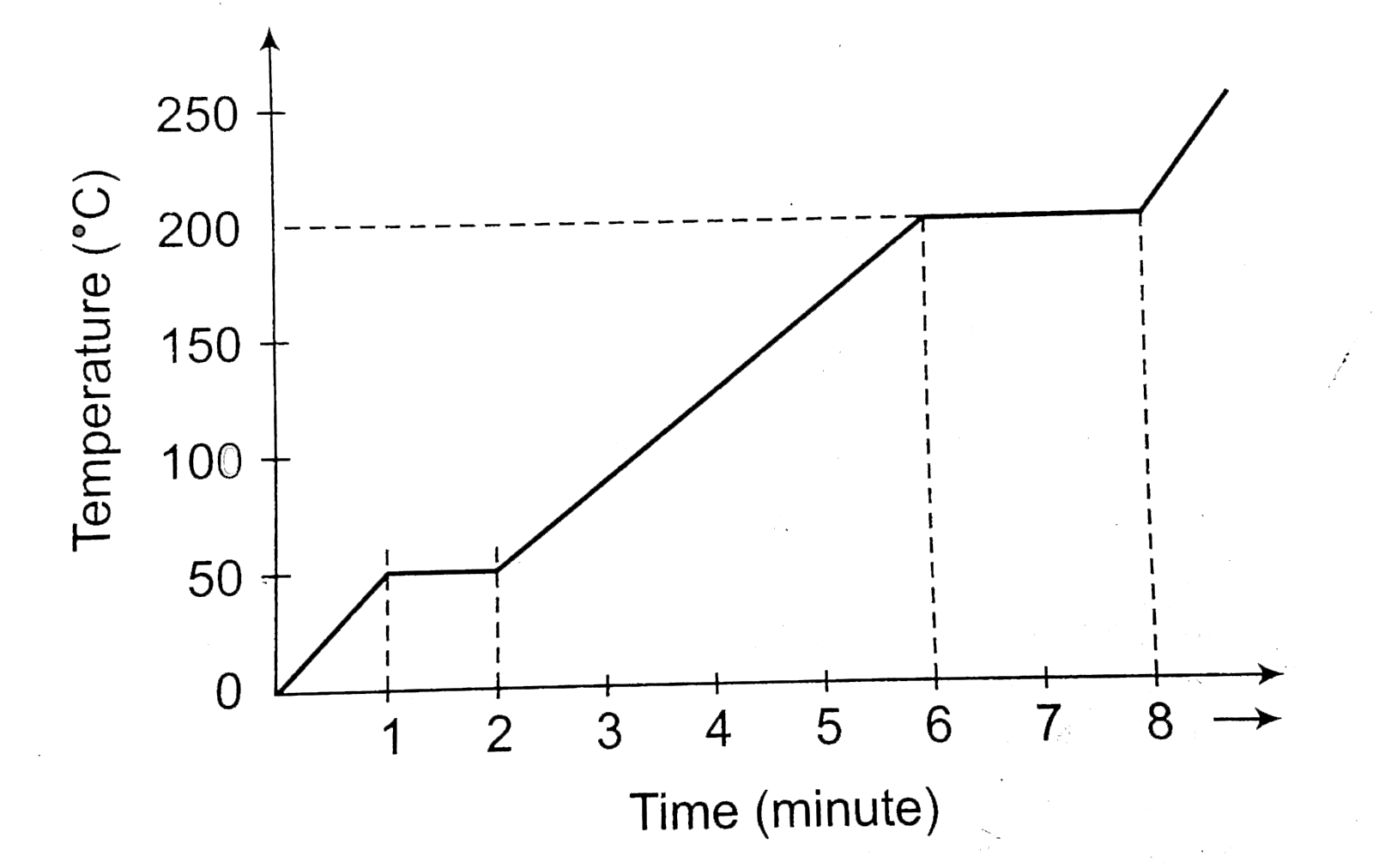
A student takes 50 g wax (specific heat `=0.6 kcal//kg^(@)C`) and heats it till it boils. The graph between temperature and time is as follows. Heat supplied to the wax per minute and boiling point are respectively.
View SolutionConsider two identical iron spheres , one which lie on a thermally insulating plate, while the other hangs from an insulatory thread. Equal amount of heat is supplied to the two spheres, then
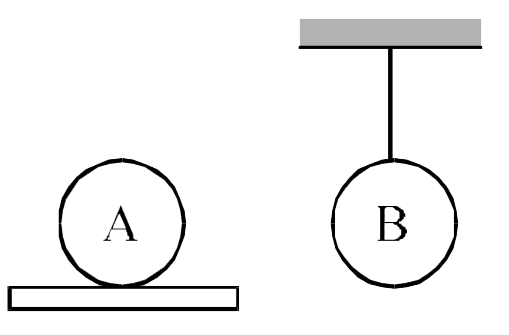
View SolutionStream at `100^(@)C` is passed into 20 g of water at `10^(@)C`. When water acquires a temperature of `80^(@)C`, the mass of water present will be [Take specific heat of water `=1 cal g^(-1) .^(@)C^(-1)` and latent heat of steam `=540 cal g^(-1)`]
View SolutionTwo solid spheres of radii `R_(1)` and `R_(2)` are made of the same material and have similar surfaces. These are raised to the same temperature and then allowed to cool under identical conditions. The ratio of their initial rates of loss of heat are
View Solution
All Questions questions and complete solutions for chapter THERMAL PROPERTIES OF MATTER of DISHA PHYSICS (HINGLISH) of Class 11